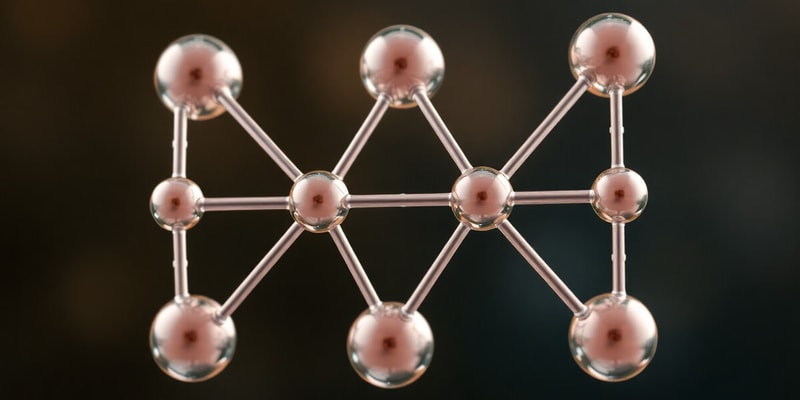Podcast
Questions and Answers
The angle for methane (CH4) is exactly 109.5°.
The angle for methane (CH4) is exactly 109.5°.
True
In the VSEPR theory, bonding pairs of electrons repel more strongly than lone pairs.
In the VSEPR theory, bonding pairs of electrons repel more strongly than lone pairs.
False
The actual bond angle in the sulfite ion (SO32–) is 109.5°.
The actual bond angle in the sulfite ion (SO32–) is 109.5°.
False
The ferrous hexaaqua ion is represented as Fe(H2O)62+.
The ferrous hexaaqua ion is represented as Fe(H2O)62+.
Signup and view all the answers
In VSEPR theory, a multiple bond is treated as if it were a single bond.
In VSEPR theory, a multiple bond is treated as if it were a single bond.
Signup and view all the answers
The bond angle for water (H2O) is greater than that of ammonia (NH3).
The bond angle for water (H2O) is greater than that of ammonia (NH3).
Signup and view all the answers
Energetically, it is more favorable for lone pairs to be as close to each other as possible.
Energetically, it is more favorable for lone pairs to be as close to each other as possible.
Signup and view all the answers
The ion FeSO4 contains ferrous ions (Fe2+).
The ion FeSO4 contains ferrous ions (Fe2+).
Signup and view all the answers
The bond angle in the sulfite ion is the same as that in methane.
The bond angle in the sulfite ion is the same as that in methane.
Signup and view all the answers
Lone pair repulsions have the least effect on molecular shape in VSEPR theory.
Lone pair repulsions have the least effect on molecular shape in VSEPR theory.
Signup and view all the answers
Sulfur hexafluoride is used to enhance the echogenicity of blood in ultrasound imaging.
Sulfur hexafluoride is used to enhance the echogenicity of blood in ultrasound imaging.
Signup and view all the answers
EDTA is a metal ion that can form octahedral complexes.
EDTA is a metal ion that can form octahedral complexes.
Signup and view all the answers
The molecular shape of a complex formed by a divalent transition metal ion with EDTA is tetrahedral.
The molecular shape of a complex formed by a divalent transition metal ion with EDTA is tetrahedral.
Signup and view all the answers
When FeSO4 dissolves in water, Fe2+ ions do not interact with the water molecules.
When FeSO4 dissolves in water, Fe2+ ions do not interact with the water molecules.
Signup and view all the answers
Echogenicity refers to the ability of tissues to reflect ultrasound waves.
Echogenicity refers to the ability of tissues to reflect ultrasound waves.
Signup and view all the answers
The molecular shape of ammonia (NH3) is trigonal planar.
The molecular shape of ammonia (NH3) is trigonal planar.
Signup and view all the answers
EDTA can chelate both monovalent and divalent transition metal ions.
EDTA can chelate both monovalent and divalent transition metal ions.
Signup and view all the answers
The molecular shape of water (H2O) is linear.
The molecular shape of water (H2O) is linear.
Signup and view all the answers
Cisplatin has a square planar molecular shape.
Cisplatin has a square planar molecular shape.
Signup and view all the answers
The octahedral molecular shape denotes six identical groups surrounding a central atom.
The octahedral molecular shape denotes six identical groups surrounding a central atom.
Signup and view all the answers
Sulfur hexafluoride (SF6) is an example of a tetrahedral molecule.
Sulfur hexafluoride (SF6) is an example of a tetrahedral molecule.
Signup and view all the answers
The main application of sulfur hexafluoride is its use in dry eye lubricants.
The main application of sulfur hexafluoride is its use in dry eye lubricants.
Signup and view all the answers
Disodium edetate is another name for ethylenediaminetetraacetic acid.
Disodium edetate is another name for ethylenediaminetetraacetic acid.
Signup and view all the answers
In sulfur hexafluoride (SF6), the bond angle between the fluorine atoms is approximately 90 degrees.
In sulfur hexafluoride (SF6), the bond angle between the fluorine atoms is approximately 90 degrees.
Signup and view all the answers
There are four bonding pairs and two lone pairs in the molecular shape of cisplatin.
There are four bonding pairs and two lone pairs in the molecular shape of cisplatin.
Signup and view all the answers
A higher signal to noise ratio in echocardiography can be achieved by reducing the echogenicity of the blood.
A higher signal to noise ratio in echocardiography can be achieved by reducing the echogenicity of the blood.
Signup and view all the answers
Ammonia (NH3) contains a double bond between nitrogen and hydrogen.
Ammonia (NH3) contains a double bond between nitrogen and hydrogen.
Signup and view all the answers
The molecular structure of water leads to its high boiling point compared to other similar-sized molecules.
The molecular structure of water leads to its high boiling point compared to other similar-sized molecules.
Signup and view all the answers
The density of sulfur hexafluoride (SF6) is lower than that of air.
The density of sulfur hexafluoride (SF6) is lower than that of air.
Signup and view all the answers
The presence of lone pairs of electrons affects the molecular shape of certain compounds.
The presence of lone pairs of electrons affects the molecular shape of certain compounds.
Signup and view all the answers
Study Notes
Molecular Shapes
- AB3E: Trigonal Pyramidal - Example: NH3 (ammonia)
- AB2E2: Bent, Angular, V-shaped - Example: H2O (water)
- AB4E2: Square Planar - Example: cis-PtCl2(NH3)2 (cisplatin)
- AB6: Octahedral - Example: SF6 (sulfur hexafluoride)
VSEPR Theory
- The central atom (A) is surrounded by valence electron pairs
- Bond pairs (B) and lone pairs (E) are calculated
- Lone/lone pair repulsions are greater than lone/bond pair repulsions, which are greater than bond/bond pair repulsions
- Lone pairs are positioned as far away from each other as possible
- Examples: SO32- (sulfite) = 106° angle, H2O = 104.5° angle, NH3 = 107° angle
Multiple Bonds
- Multiple bonds are treated as single bonds in VSEPR theory
- This simplifies calculations and avoids issues associated with resonance structures
Studying That Suits You
Use AI to generate personalized quizzes and flashcards to suit your learning preferences.
Related Documents
Description
Explore the fascinating world of molecular shapes through VSEPR theory. This quiz covers various molecular geometries such as trigonal pyramidal, bent, square planar, and octahedral forms. Test your understanding of electron pair repulsions and the impact of multiple bonds on molecular geometry.




